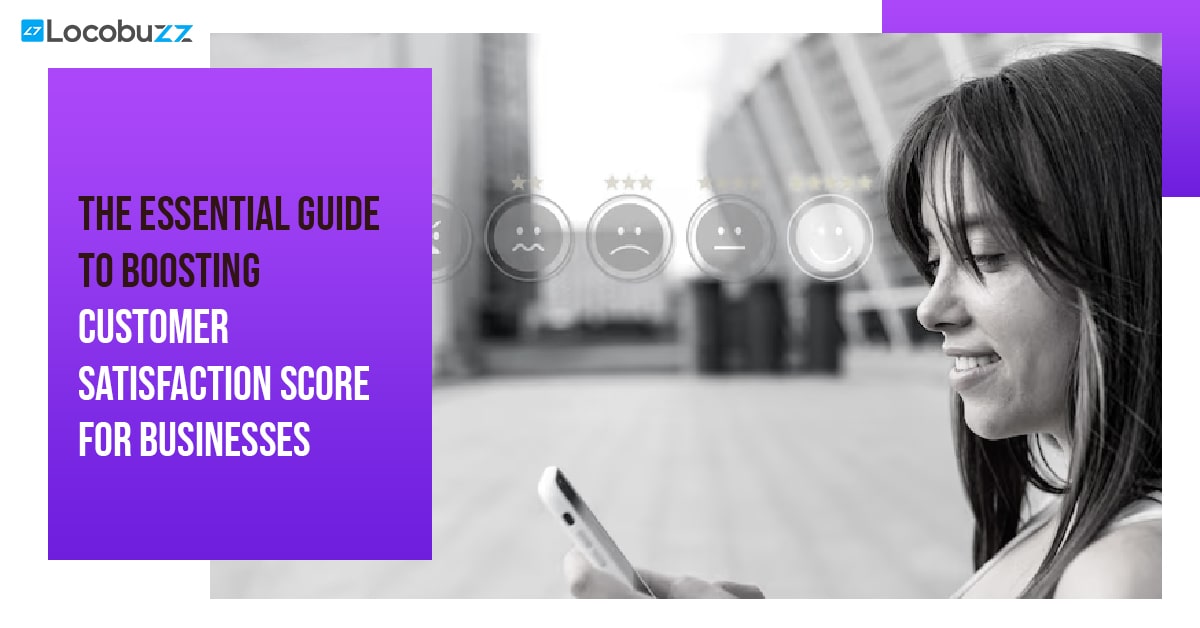The Essential Guide to Boosting Customer Satisfaction Score for Businesses
 Customer satisfaction is a crucial aspect of any successful business.
Customer satisfaction is a crucial aspect of any successful business.
One of the most popular methods of measuring customer satisfaction is through a customer satisfaction score (CSS).
In this blog, we’ll explore what CSS is, how it works, and why it’s essential for businesses to understand it. We’ll also provide tips for improving CSS and using it to enhance customer experience and ultimately, drive business growth.
Table of Contents
What is Customer Satisfaction Score?
Customer Satisfaction Score (CSS) is a metric that is used by businesses to measure how satisfied their customers are with the products or services they offer. It is a simple and effective way to gauge customer satisfaction and to identify areas that require improvement.
Typically, CSS is measured using a survey that asks customers to rate their level of satisfaction with a particular product, service, or interaction with the company.
The survey usually includes a scale of 1 to 10, with 10 being the highest level of satisfaction. The average score is then calculated to determine the overall CSS. CSS is an essential metric for businesses to track because it directly impacts customer loyalty, repeat business, and ultimately, the bottom line.
Why do we measure Customer Satisfaction Score?
There are several reasons why measuring Customer Satisfaction Score (CSS) is important for businesses. Here are a few key reasons:
- Identify areas for improvement: CSS surveys provide valuable feedback that can help businesses identify areas where they need to improve. By understanding what customers are not satisfied with, businesses can make the necessary changes to improve customer experience and increase satisfaction levels.
- Retain customers: Satisfied customers are more likely to become repeat customers and recommend the business to others. By measuring CSS, businesses can identify areas where they may be losing customers and take steps to retain them.
- Stay competitive: In today’s highly competitive business environment, providing a positive customer experience is crucial. Measuring CSS helps businesses stay competitive by identifying areas where they can differentiate themselves from their competitors and provide a better customer experience.
- Increase revenue: Satisfied customers are more likely to spend more money with a business and are more likely to refer others. By improving CSS, businesses can increase customer loyalty, retention, and revenue.
Measuring CSS is an essential part of any business’s customer experience strategy. It provides valuable insights into customer satisfaction levels and helps businesses make data-driven decisions to improve customer experience and drive business growth.
What Is a Good CSAT Score?
The definition of a good Customer Satisfaction Score (CSS) can vary depending on the industry, company size, and other factors. Generally, a CSS score above 80% is considered good, but this may not be true for every business. It’s important to note that CSS is relative and needs to be benchmarked against the industry standards and competitors.
The interpretation of CSS depends on the context in which it is used. A high CSS score may indicate that the business is meeting customer expectations, while a low score may indicate that the business needs to improve its customer experience. It is essential to analyze the results of CSS surveys carefully and use them as a tool for continuous improvement.
It’s also important to note that CSS is just one metric for measuring customer satisfaction. Companies should use multiple metrics to measure customer experience and satisfaction, such as Net Promoter Score (NPS) and Customer Effort Score (CES), to get a more comprehensive understanding of how customers perceive the business.
How to measure your Customer Satisfaction Score
Here below is the segregated pointers for better understanding on how to measure the Customer satisfaction Score.
- Define your survey questions: To get meaningful insights from your CSS survey, it’s important to ask the right questions. Start by defining the objective of the survey and the specific areas of your business you want to assess. For example, you may want to ask questions about the quality of your product or service, the responsiveness of your customer service team, or the ease of using your website or app. Keep the survey questions simple, clear, and specific to ensure that customers understand them.
- Choose a survey method: The survey method you choose will depend on several factors, including the type of business you have, the customer base you are targeting, and the budget you have for conducting the survey. Email and online surveys are popular and cost-effective options, but you may also consider phone or in-person surveys if that better suits your customers. Consider using a combination of survey methods to reach a broader audience.
- Determine your sample size: The sample size you need for your CSS survey will depend on the size of your customer base and the level of confidence you want to have in your results. Generally, a sample size of at least 100 customers is recommended for statistical significance. If you have a larger customer base, consider sampling a smaller percentage of customers.
- Send out the survey: Once you have defined your survey questions, chosen a survey method, and determined your sample size, it’s time to send out the survey. Make sure to provide clear instructions on how to complete the survey and set a deadline for responses. You may want to consider offering incentives, such as discounts or free products, to encourage customers to participate.
- Collect and analyze the results: After you have received the survey responses, it’s time to analyze the results. Calculate the average score by adding up the responses and dividing by the total number of respondents. You can also segment the results by different customer demographics, such as age, gender, or location, to gain deeper insights into customer preferences and behavior.
- Take action: The most important step in measuring CSS is to take action on the survey results. Use the feedback to identify areas where you need to improve, and develop an action plan to address customer concerns. Make sure to communicate the results and action plan to your team and customers to show that you are committed to providing an excellent customer experience.
By following these steps, businesses can measure CSS and use the results to improve customer experience and drive business growth. Remember to conduct CSS surveys regularly to track changes in customer satisfaction over time and make continuous improvements to your products and services.
How will it help business to improve their CX game?
Measuring Customer Satisfaction Score (CSS) can help businesses improve their customer experience (CX) game in several ways:
- Identify areas for improvement: CSS surveys can help businesses identify specific areas where they need to improve to provide a better customer experience. For example, if customers consistently rate the quality of a product or service as low, the business can investigate the reasons for the low ratings and take steps to improve the quality.
- Gauge the effectiveness of customer service: CSS surveys can help businesses understand how effective their customer service is in resolving customer issues and concerns. This information can be used to train customer service representatives to provide better support, which can lead to higher customer satisfaction levels.
- Increase customer loyalty: CSS surveys can also help businesses increase customer loyalty by identifying the factors that contribute to customer satisfaction. By addressing these factors, businesses can improve their overall customer experience and increase the likelihood that customers will return to do business again.
- Enhance brand reputation: By consistently measuring and improving CSS, businesses can enhance their brand reputation and differentiate themselves from competitors. Customers are more likely to recommend a business to others if they have a positive experience, which can help to drive new business.
- Reduce customer churn: Measuring CSS can also help businesses identify customers who are at risk of churning, or leaving for a competitor. By proactively addressing customer concerns and improving the overall customer experience, businesses can reduce churn rates and retain more customers over time.
Measuring CSS can help businesses improve their CX game by providing valuable insights into customer preferences, concerns, and behavior. By using this information to make strategic changes, businesses can provide a better customer experience, increase customer loyalty, and drive business growth.
Benefits of tracking CSS for businesses
Tracking Customer Satisfaction Score (CSS) can provide numerous benefits for businesses, including:
- Customer retention: Tracking CSS can help businesses identify customers who are at risk of leaving and take proactive measures to retain them. By addressing customer concerns and improving the overall customer experience, businesses can reduce churn rates and retain more customers over time.
- Competitive advantage: CSS tracking can help businesses differentiate themselves from competitors by consistently providing a better customer experience. This can enhance brand reputation and increase customer loyalty, which can ultimately drive business growth.
- Improved products and services: CSS tracking can provide valuable feedback on product or service quality, which can help businesses identify areas for improvement. By addressing customer concerns and making necessary changes, businesses can improve the quality of their products and services and provide a better customer experience.
- Better customer support: Tracking CSS can help businesses identify areas where customer support can be improved. By providing better support, businesses can increase customer satisfaction levels and build stronger relationships with customers.
- Greater customer loyalty: Tracking CSS can help businesses understand what customers value most and what drives loyalty. By focusing on these factors, businesses can provide a better customer experience and increase customer loyalty over time.
- Cost savings: Tracking CSS can help businesses identify areas where they may be wasting resources or where they can make changes to reduce costs. For example, if customers consistently report issues with a particular product feature, the business may decide to invest resources in fixing the issue rather than continuing to offer a feature that customers do not value.
Tracking CSS can provide numerous benefits for businesses, including improved customer retention, competitive advantage, better products and services, improved customer support, greater customer loyalty, and cost savings. By using CSS tracking as a tool for continuous improvement, businesses can provide a better customer experience and drive business growth.
Common methods of measuring Customer Satisfaction Score
Below are listed some of the methods that can be helpful in measuring customer satisfaction Score. The third method in it can be proven helpful
- Surveys: Surveys are the most common method of measuring Customer Satisfaction Score (CSS). The survey can be conducted through various channels such as email, website, or social media. The survey can include multiple-choice questions, rating scales, and open-ended questions to gather both quantitative and qualitative data. Surveys are typically conducted periodically or after a specific customer interaction, such as a purchase or customer service call.
- Feedback Forms: Feedback forms are another method of measuring CSS. They can be used to gather feedback on specific products or services, customer support interactions, or the overall customer experience. Feedback forms can be distributed through various channels such as email, website, or social media. They typically include rating scales and open-ended questions to gather both quantitative and qualitative data. Feedback forms can be conducted periodically or after a specific customer interaction.
- Locobuzz CX platform: The Locobuzz CX platform is a comprehensive customer experience management platform that includes a variety of tools to measure CSS. The platform includes sentiment analysis, customer feedback management, and social listening tools to gather data on customer sentiment and feedback. The platform also includes customer journey mapping and analytics tools to help businesses understand how customers interact with their brand and identify areas for improvement. The Locobuzz CX platform is a comprehensive solution for measuring CSS and improving the overall customer experience.
Surveys and feedback forms are the most common methods of measuring CSS, while platforms like Locobuzz CX offer more comprehensive solutions that include sentiment analysis, customer feedback management, social listening, customer journey mapping, and analytics. Businesses can choose the method that best suits their needs and budget to measure CSS and improve the overall customer experience.
How to improve customer Satisfaction Score
Improving Customer Satisfaction Score (CSS) is crucial for businesses that want to provide a better customer experience and increase customer loyalty. Here are some strategies that businesses can use to improve their CSS:
Identify customer pain points: Analyze customer feedback to identify common pain points and areas for improvement. Once you have identified these areas, prioritize them and create an action plan to address them.
Provide excellent customer support: Ensure that your customer support team is well-trained, responsive, and empathetic. By providing excellent customer support, you can quickly resolve customer issues and improve customer satisfaction.
Personalize the customer experience: Personalization can go a long way in improving customer satisfaction. Use customer data to personalize communications and offers to individual customers.
Improve product or service quality: Improving the quality of your products or services is crucial for improving customer satisfaction. Analyze customer feedback to identify areas for improvement and make necessary changes.
Streamline the customer journey: Simplify the customer journey by reducing friction points, such as long wait times, complicated checkout processes, or confusing website navigation. A streamlined customer journey can enhance the overall customer experience and improve customer satisfaction.
Foster a customer-centric culture: A customer-centric culture prioritizes the customer experience and ensures that all employees understand the importance of providing excellent customer service. By fostering a customer-centric culture, businesses can improve customer satisfaction and build stronger customer relationships.
Improving CSS requires a holistic approach that includes analyzing customer feedback, providing excellent customer support, personalizing the customer experience, improving product or service quality, streamlining the customer journey, and fostering a customer-centric culture. By consistently implementing these strategies, businesses can improve their CSS and provide a better customer experience.
Common mistakes to avoid when measuring and improving CSS
Sure, here’s a more detailed explanation of the common mistakes to avoid when measuring and improving Customer Satisfaction Score (CSS):
- Focusing solely on the score: While CSS is an important metric to track, it’s crucial not to fixate solely on the number. CSS should be viewed as a tool for measuring customer satisfaction, but it’s essential to remember that each score represents an individual customer with unique needs and expectations. To improve CSS, businesses must take a customer-centric approach and prioritize meeting customer needs and exceeding expectations.
- Ignoring negative feedback: Negative feedback can be challenging to hear, but it’s crucial to address it and take action to resolve issues. Ignoring negative feedback can damage your reputation and cause customers to take their business elsewhere. When customers provide negative feedback, it’s an opportunity to learn and improve the customer experience. By addressing concerns and implementing changes based on feedback, businesses can demonstrate their commitment to customer satisfaction.
- Not setting specific goals: To improve CSS, businesses must set specific, measurable goals. Without clear goals, it’s challenging to track progress and make meaningful improvements. Specific goals might include increasing the percentage of customers who rate their experience as “very satisfied” or reducing the number of complaints received. By setting specific goals, businesses can focus their efforts on making improvements that matter to customers.
- Failing to communicate changes to customers: When making changes based on customer feedback, it’s important to communicate those changes to customers. Failing to do so can create confusion and frustration. Customers appreciate being kept in the loop and want to know that their feedback is being heard and acted upon. By communicating changes and improvements to customers, businesses can build trust and demonstrate their commitment to customer satisfaction.
- Treating CSS as a one-time project: CSS should be an ongoing focus for businesses, not a one-time project. Continuously monitoring and improving CSS is essential for building a strong reputation and retaining customers. CSS should be viewed as an ongoing process of listening to customer feedback, making improvements, and measuring results. By making CSS a priority and investing in ongoing improvements, businesses can demonstrate their commitment to providing an excellent customer experience.
- Not involving employees in the process: Employees play a critical role in providing excellent customer service and improving CSS. It’s important to involve them in the process, provide training, and empower them to make decisions that benefit customers. By involving employees and providing them with the tools and training they need to excel, businesses can create a culture of customer service excellence.
Overlooking the importance of CX culture: A customer-centric culture is essential for improving CSS. Leaders must prioritize customer satisfaction and build a culture that values and prioritizes the customer experience. This means involving employees in the process, empowering them to make decisions that benefit customers, and investing in ongoing training and development. By building a culture that values the customer experience, businesses can create a competitive advantage and drive long-term success.
Role of Technology in Improving Customer Satisfaction Score
Technology plays a significant role in improving Customer Satisfaction Score (CSS) by enabling businesses to gather and analyze customer data, personalize customer experiences, streamline operations, and provide faster and more efficient customer support. Here are some ways in which technology can improve CSS:
- Data gathering and analysis: With the help of technology, businesses can collect and analyze customer data, including feedback, purchase history, and browsing behavior. This data can be used to identify customer preferences, pain points, and trends, which can help businesses improve their products or services.
- Personalization: Technology can be used to personalize the customer experience by using customer data to tailor marketing messages, offers, and recommendations to individual customers. Personalization can enhance the customer experience and improve customer satisfaction.
- Automation: Technology can automate routine tasks, such as order processing, invoicing, and customer support, which can save time and reduce errors. Automation can help businesses provide faster and more efficient service to customers, which can improve customer satisfaction.
- Omnichannel communication: Technology enables businesses to communicate with customers through multiple channels, including email, social media, live chat, and phone. Omnichannel communication can provide customers with more options for getting in touch with a business and can improve the overall customer experience.
- Self-service options: Technology can provide customers with self-service options, such as FAQ pages, knowledge bases, and chatbots, which can help them find answers to their questions quickly and easily. Self-service options can reduce the workload on customer support teams and improve customer satisfaction.
Technology can play a significant role in improving CSS by enabling businesses to gather and analyze customer data, personalize the customer experience, automate routine tasks, provide omni channel communication, and offer self-service options. By leveraging technology, businesses can enhance the overall customer experience and improve customer satisfaction.
Final Thoughts
Customer Satisfaction Score (CSS) is an essential metric that businesses should measure and track regularly. CSS can help businesses understand how satisfied their customers are with their products or services and identify areas for improvement. By implementing strategies such as identifying customer pain points, providing excellent customer support, personalizing the customer experience, improving product or service quality, streamlining the customer journey, and fostering a customer-centric culture, businesses can improve their CSS and provide a better customer experience.
Additionally, technology plays a crucial role in improving CSS by enabling businesses to gather and analyze customer data, personalize customer experiences, automate routine tasks, provide omnichannel communication, and offer self-service options. By leveraging Locobuzz and implementing our strategies, businesses can improve customer satisfaction, increase customer loyalty, and ultimately drive business growth.

















